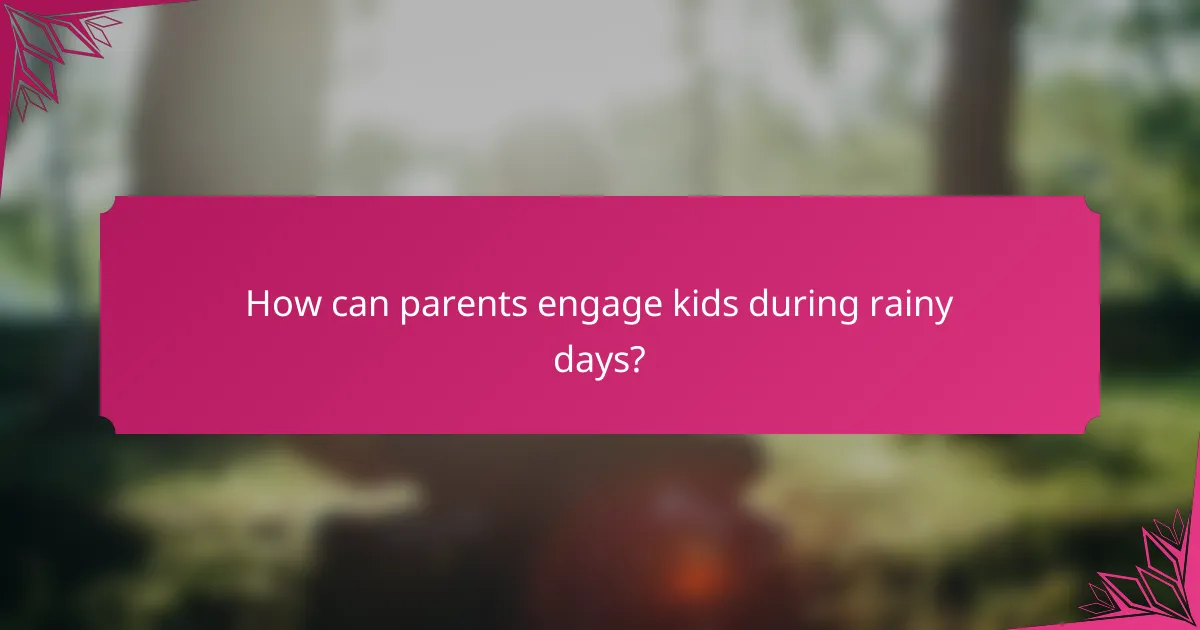When rainy days keep kids indoors, it’s the perfect opportunity to spark their creativity with engaging activities. From DIY crafts and scavenger hunts to cooking and storytelling, these fun ideas not only entertain but also promote skill development and family bonding. Embrace the chance to transform a dreary day into an exciting adventure filled with imagination and play.

What are the best creative activities for kids indoors?
The best creative activities for kids indoors engage their imagination and keep them entertained while developing various skills. Options like DIY crafts, scavenger hunts, cooking, storytelling, and science experiments offer fun and educational experiences that can be tailored to different age groups.
DIY craft projects
DIY craft projects are an excellent way for kids to express their creativity while working with their hands. Simple materials such as paper, scissors, glue, and recyclable items can be transformed into art pieces or useful objects. Consider projects like making greeting cards, creating paper mâché sculptures, or designing personalized bookmarks.
To keep things organized, set up a designated crafting area with all necessary supplies. Encourage kids to explore their ideas freely, but provide guidance on techniques or safety when using tools like scissors or glue guns.
Indoor scavenger hunts
Indoor scavenger hunts can turn a regular day into an exciting adventure. Create a list of items for kids to find around the house, such as a red toy, a book with animals, or a kitchen utensil. You can also add riddles or clues to make it more challenging and engaging.
To enhance the experience, consider setting a timer for added excitement or offering small prizes for completing the hunt. This activity promotes problem-solving skills and can be easily adapted for different age levels by varying the difficulty of the clues.
Cooking and baking activities
Cooking and baking activities are not only fun but also teach kids valuable life skills. Choose simple recipes that allow children to participate in various steps, like measuring ingredients, mixing, and decorating. Recipes for cookies, pizzas, or homemade smoothies are great starting points.
Always supervise kids in the kitchen, especially when using knives or the oven. Discussing measurements and cooking times can also help reinforce math skills in a practical context.
Interactive storytelling sessions
Interactive storytelling sessions can ignite a child’s imagination and improve their language skills. Encourage kids to create their own stories or act out their favorite books. Use props or costumes to make the experience more immersive and engaging.
Consider incorporating storytelling games where children take turns adding to a story, fostering collaboration and creativity. This activity can be adapted for various age groups by adjusting the complexity of the stories or the level of involvement required.
Science experiments at home
Science experiments at home provide hands-on learning opportunities that can spark curiosity. Simple experiments, such as creating a volcano with baking soda and vinegar or growing crystals with sugar, can be both educational and entertaining. Ensure that the materials used are safe and suitable for children.
Before starting an experiment, explain the scientific principles involved to enhance understanding. Encourage kids to make predictions about the outcomes and discuss the results afterward, reinforcing critical thinking skills.

How can parents engage kids during rainy days?
Parents can keep kids entertained on rainy days by providing a variety of fun and creative activities that stimulate their imagination and energy. Engaging in indoor play not only alleviates boredom but also fosters family bonding and skill development.
Board games and puzzles
Board games and puzzles are excellent options for rainy day entertainment, promoting critical thinking and teamwork. Choose games that suit your children’s ages and interests, ranging from classic options like Monopoly to modern strategy games like Catan.
Consider setting up a game tournament with small prizes to increase excitement. Puzzles can also be a great way to spend time together; opt for ones with themes your kids enjoy, such as animals or superheroes, to keep them engaged.
Indoor obstacle courses
Creating an indoor obstacle course can transform your living space into a fun and active environment. Use cushions, chairs, and blankets to design a course that challenges kids to crawl, jump, and balance.
Encourage creativity by allowing kids to help set up the course and come up with their own challenges. Time each participant to add a competitive element, and consider rewarding the fastest time with a small treat or privilege.
Movie marathons with themed snacks
Hosting a movie marathon is a cozy way to spend a rainy day, especially when paired with themed snacks. Choose a series of films that your kids love, such as animated classics or superhero adventures, and plan snacks that match the theme.
For example, if watching a pirate movie, serve popcorn with a sprinkle of sea salt and gummy fish. Create a comfortable viewing area with blankets and pillows to enhance the experience, making it feel like a special event.
Art and painting sessions
Art and painting sessions allow kids to express their creativity while developing fine motor skills. Set up a designated area with various supplies like paints, markers, and paper, and encourage kids to create their own masterpieces.
Consider providing prompts or themes, such as “nature” or “fantasy,” to inspire their artwork. Display their creations around the house to boost their confidence and show appreciation for their efforts.

What are some outdoor activities for kids in urban areas?
Outdoor activities for kids in urban areas can be both fun and engaging, providing opportunities for exploration and teamwork. These activities often utilize local parks, community spaces, and urban environments to foster creativity and physical activity.
Park scavenger hunts
Park scavenger hunts are an exciting way for kids to explore their surroundings while developing observation skills. Parents or organizers can create a list of items or landmarks for children to find, such as specific types of leaves, park benches, or playground equipment.
To enhance the experience, consider incorporating a theme, such as nature or local history. This can make the hunt more educational and engaging. Always ensure that the scavenger hunt is safe and that kids stay within designated park areas.
Community gardening projects
Community gardening projects allow kids to learn about nature, responsibility, and teamwork while contributing to their local environment. These projects often involve planting flowers, vegetables, or herbs in shared spaces, which can be both rewarding and educational.
To get started, check for local community gardens that welcome youth participation. Many organizations provide tools and guidance, making it easy for kids to engage in gardening activities. Encourage kids to take ownership of their plants and track their growth over time.
Outdoor sports and games
Outdoor sports and games provide a great way for kids to stay active and socialize. Popular options include soccer, basketball, and tag, which can be played in parks or open spaces. These activities promote physical fitness and teamwork.
When organizing sports, consider the age and skill levels of the participants to ensure everyone can enjoy the game. Setting up a small tournament or friendly matches can also encourage friendly competition and community spirit.

How to choose the right activities for different age groups?
Selecting the right activities for various age groups involves understanding their developmental stages and interests. Tailoring activities to fit these factors ensures engagement and safety, making playtime both fun and beneficial.
Age-appropriate skill levels
Activities should match the skill levels of children in different age groups. For toddlers, simple tasks like stacking blocks or finger painting are ideal, while preschoolers may enjoy more complex activities like basic puzzles or simple crafts. School-aged children can handle projects that require critical thinking, such as building models or engaging in science experiments.
Consider the cognitive and physical abilities of each age group when planning activities. For example, activities for children aged 5-7 should encourage fine motor skills, while those for ages 8-12 can focus on teamwork and problem-solving.
Safety considerations for activities
Safety is paramount when choosing activities for kids. Always check that materials are non-toxic and age-appropriate. For instance, small parts can pose choking hazards for younger children, so opt for larger items for toddlers and preschoolers.
Additionally, supervise children during activities, especially those involving tools or outdoor play. Establish clear boundaries and guidelines to ensure a safe environment. Regularly inspect play areas for hazards, and ensure that any equipment used meets safety standards relevant to your location.

What are the benefits of engaging kids in creative play?
Engaging kids in creative play fosters their imagination, problem-solving skills, and emotional development. It encourages them to express themselves and explore new ideas, leading to enhanced cognitive abilities and social skills.
Enhances problem-solving skills
Creative play challenges children to think critically and devise solutions to various scenarios. By engaging in activities like building with blocks or solving puzzles, kids learn to approach problems from different angles and develop resilience when faced with challenges.
For example, when children build a fort, they must consider structural stability and spatial awareness. This hands-on experience translates into improved analytical skills that benefit them in academic settings.
Boosts emotional development
Through creative play, children can express their feelings and learn to manage emotions. Activities such as role-playing or storytelling allow them to explore different perspectives and practice empathy.
Encouraging kids to engage in imaginative play, like pretending to be a doctor or a teacher, helps them process their experiences and understand social dynamics. This emotional intelligence is crucial for building healthy relationships later in life.
Improves social skills
Creative play often involves collaboration, which is essential for developing social skills. When kids play together, they learn to share, negotiate, and communicate effectively.
Group activities, such as art projects or team sports, provide opportunities for children to practice teamwork and conflict resolution. These interactions help them build friendships and navigate social situations more confidently.
